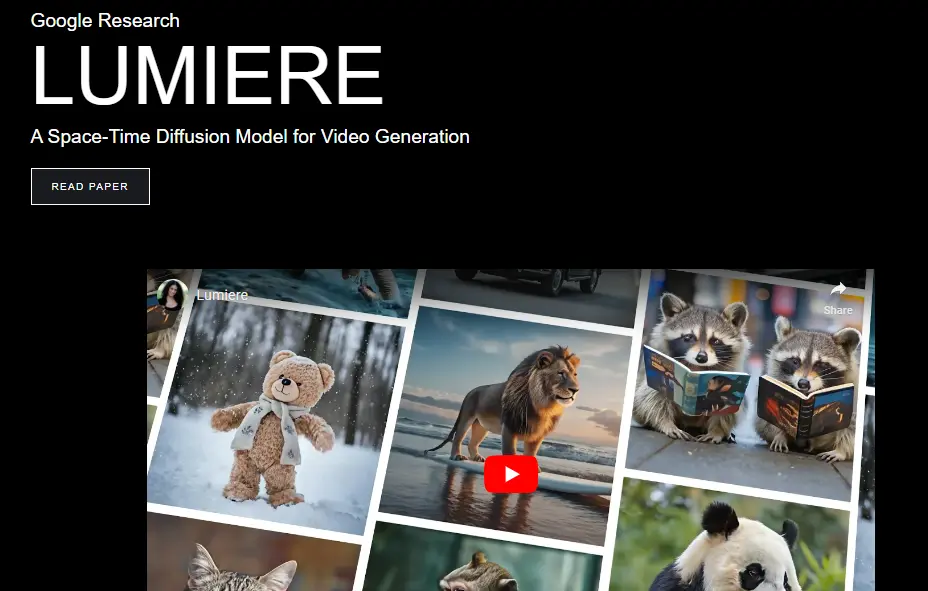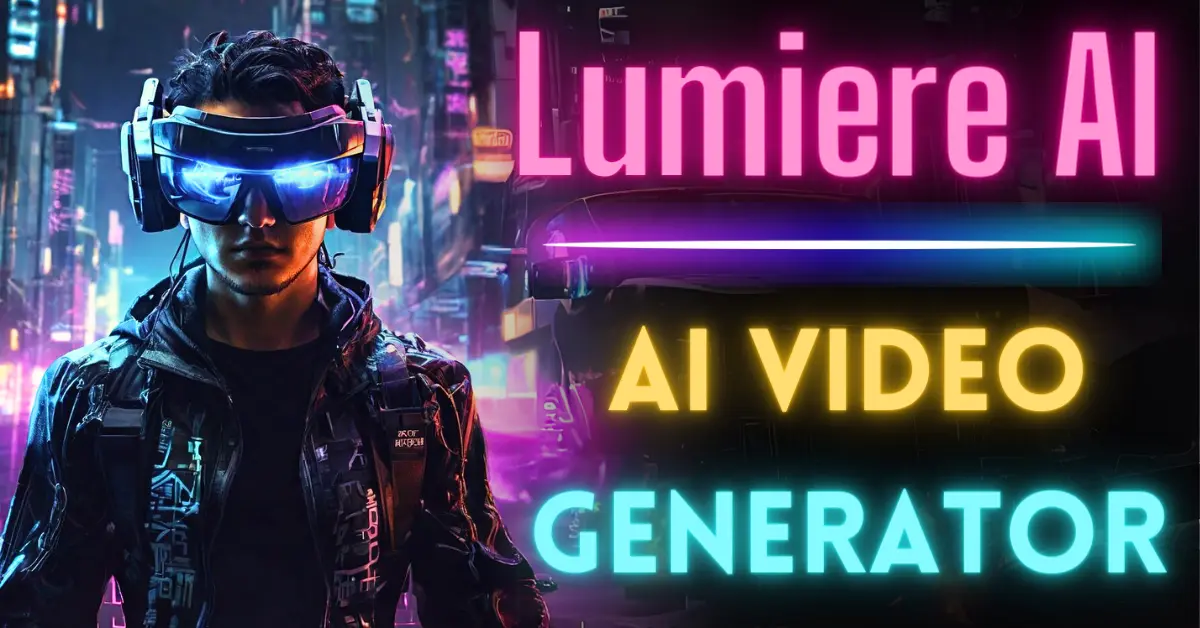Recently, Google Research revealed a groundbreaking paper showcasing their latest achievement: the LUMIERE AI Video Generator. This innovative text-to-video model promises to be the model of its kind, setting a new standard in the field.
In this article, we will explore the key features and advancements of LUMIERE, providing a step-by-step guide to understanding its architecture and capabilities.
What is Google Lumiere AI Video Generator
Google Lumiere is an AI text-to-video and image-to-video artificial intelligence (AI) model under development by Google Research. It utilizes a revolutionary “Space-Time U-Net architecture” to generate realistically fluid and detailed videos from textual descriptions or reference images.

Here’s a breakdown of its key features:
1. Text-to-video generation:
Create high-quality videos based on written prompts, allowing anyone to turn their imagination into moving pictures.
2. Image-to-video animation:
Breathe life into still images, adding context, movement, and stylistic variations.
3. Advanced video editing capabilities:
Fine-tune specific elements like lighting, style, and object movement within the generated video.
4. Realistic and consistent output:
Achieve unparalleled fluidity and detail thanks to the innovative approach that considers both spatial and temporal aspects simultaneously.
5. Versatility beyond text-to-video:
Generate cinematography, repair damaged footage, and explore exciting creative possibilities like interactive video experiences.
The Impressive Video Demos
Google has shared fascinating demo videos on the lumiere-video.github.io. These demonstrations offer a glimpse into the model’s capabilities, showcasing its ability to generate highly realistic and coherent videos.
Consistency in Video Rendering
A standout feature of LUMIERE is its consistency in video rendering. Unlike traditional video generation models that create keyframes and fill in the gaps, LUMIERE generates the entire temporal duration of the video in one go.
This is achieved through its unique SpaceTime unit architecture, efficiently handling both spatial and temporal aspects of the video data.
- User Preference and Benchmarking
In user studies, LUMIERE outperformed other models in both text-to-video and image-to-video generation. Benchmarks revealed its superiority against competitors like PE collabs, zeroscope, and Gen 2 (Runway).
This establishes LUMIERE as the current gold standard in text-to-video generation, aligning with predictions that 2024 is poised to be the year for advancements in this domain.
How to use Google LUMIERE AI Video Generator?
Unfortunately, Google Lumiere is currently in the research and development phase, which means it’s not yet available for public use. Google hasn’t released any details about an official launch date or accessibility plans.
However, I can still share some information about how Lumiere might work based on the research published by Google AI:
Inputs:
- Text Prompts: You could likely provide simple text descriptions of a scene, event, or character, and Lumiere would generate a video based on your words.
- Reference Images: You could potentially upload an image as a starting point, and Lumiere would animate it, create variations of it, or generate a video scene inspired by it.
Understanding the Architecture
Now, let’s explore the architectural innovations that make LUMIERE a standout model in text-to-video generation.
1. SpaceTime Unit Architecture
LUMIERE employs the SpaceTime unit architecture, a departure from traditional models that create keyframes.
This approach allows the model to generate the entire video’s temporal duration in a single pass, resulting in more coherent and realistic motion in the generated content.
2. Temporal Downsampling and Upsampling
The model incorporates both spatial and temporal downsampling and upsampling in its architecture. This enhances its ability to process and generate full-frame-rate videos more effectively, contributing to the overall realism of the generated content.
3. Using Pre-trained Texture Image Diffusion Models
LUMIERE builds upon existing text-to-image diffusion models, adapting them for video generation.
This strategy enables the model to benefit from the strong generative capabilities of pre-trained models while extending its capabilities to handle the complexities of video data.
4. Addressing Challenges in Video Generation
LUMIERE tackles significant challenges in video generation, particularly in maintaining global temporal consistency.
The model’s architecture and training approach are specifically designed to address this challenge, ensuring that generated videos exhibit coherent and realistic motion throughout their duration.
Exploring LUMIERE’s GitHub Page
A visit to LUMIERE’s GitHub page provides a deeper understanding of its capabilities. The examples showcased on the page demonstrate the model’s advanced features, such as realistic rotations and detailed animations.
Notable examples include a rotating Lamborghini wheel, pouring beer into a glass, and a captivating fireworks display.
Stylized Generation and Beyond
LUMIERE excels not only in text-to-video generation but also in stylized video production. The model’s ability to apply various styles to videos, as demonstrated with references to the Style Drop paper, showcases its versatility.
Stylized videos, whether imitating 3D animation or mimicking famous paintings, highlight the model’s potential in creative applications.
Customization and Future Possibilities
The article also touches upon the potential for customization in video models, particularly in the context of animating specific regions within an image.
This feature, demonstrated with cinemagraphs, opens up possibilities for users to customize video content to their preferences.
The article concludes with speculation about Google’s plans for LUMIERE. The model’s potential for widespread use and its competitive edge in the text-to-video domain raise questions about whether Google will release it as a standalone product or incorporate it into a larger project.
LUMIERE AI Official paper read here.
FAQs:
1. What is Google LUMIERE AI?
Google LUMIERE AI Video Generator is an innovative model developed by Google Research for creating videos from text descriptions.
2. How does LUMIERE differ from other text-to-video models?
LUMIERE distinguishes itself with its SpaceTime unit architecture, addressing spatial and temporal challenges in video generation.
3. Can LUMIERE generate customized and stylized videos?
Yes, LUMIERE supports video stylization and customization.
4. What types of videos can LUMIERE effectively generate?
LUMIERE excels in generating diverse videos, including rotating objects like Lamborghini wheels, pouring liquids with realistic dynamics, and stylized animations such as a chocolate muffin rotating.
5. Is LUMIERE AI Video Generator available for public use?
As of now, Google has not officially released LUMIERE AI Video Generator to the public.
Conclusion
Google’s LUMIERE AI Video Generator represents a text-to-video technology. Its impressive demos, innovative architecture, and versatility in stylized generation position it as a frontrunner in the field. As we eagerly await further developments, LUMIERE sparks excitement about the future possibilities of AI-driven video generation.
